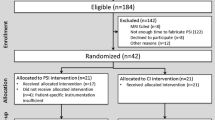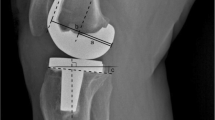Abstract
Purpose
The purpose of the present study was to evaluate factors that affect the occurrence of osteolysis through clinical and radiological comparison between a patient group in which osteolysis occurred after total knee arthroplasty (TKA) and a patient group in which osteolysis did not occur after TKA.
Methods
The present study was conducted with 486 knees that had been followed up for at least 2 years after undergoing a posterior-stabilized TKA. The subjects were divided into a group in which osteolysis occurred and a group in which osteolysis did not occur and retrospectively compared and analyzed. Knee Society Knee Score and Function Score, preoperative and postoperative range of motion (ROM), femoral and tibial implant positions, preoperative and postoperative femerotibial angles, posterior femoral condylar offset (PCO), level of joint line (JL), and posterior tibial slopes were measured and clinically and radiologically compared.
Results
Osteolysis occurred in 28 knee joints (5.7 %). No significant difference was observed between the patient group without osteolysis, and the patient group with osteolysis was observed in preoperative and postoperative ROM, femoral and tibial implant positions, or preoperative and postoperative femerotibial angles. The means of preoperative and postoperative differences in PCO and level of JL were significantly larger in the patient group with osteolysis than in the patient group without osteolysis (p = 0.01, p = 0.007), and regression analyses showed that the means of preoperative and postoperative differences in these two variables were related with the occurrence of osteolysis (p = 0.021, p = 0.018).
Conclusion
The present study shows that biomechanical changes occurring after TKA are related with the occurrence of osteolysis. For clinical relevance, surgeons should pay great attention to restore normal anatomical structure as much as possible with careful preoperative plans, accurate surgical techniques, and selection of appropriate implants.
Level of evidence
Retrospective comparative study, Level III.

Similar content being viewed by others
References
Bauer T, Biau D, Colmar M, Poux X, Hardy P, Lortat-Jakob A (2010) Influence of posterior condylar offset on knee flexion after cruciate-sacrificing mobile-bearing total knee replacement: a prospective analysis of 410 consecutive cases. Knee 17:375–380
Buechel FF, Pappas MJ (1989) New Jersy low contact stress knee replacement system. Ten-year evaluation of meniscal bearings. Orthop Clin North Am 20:147–177
Callaghan JJ, O’Rourke MR, Goetz DD, Schmalzried TP, Campbell PA, Johnston RC (2002) Tibial post impingement in posterior-stabilized total knee arthroplasty. Clin Orthop Relat Res 404:83–88
Catani F, Leardini A, Ensini A, Cucca G, Bragonzoni L, Toksviq-Larsen S, Giannini S (2004) The stability of the cemented tibial component of total knee arthroplasty: posterior cruciate-retaining versus posterior-stabilized design. J Arthroplast 19:775–782
Cope MR, O’Brien BS, Nanu AM (2002) The influence of the posterior cruciate ligament in the maintenance of joint line in primary total knee arthroplasty: a radiologic study. J Arthroplast 17:206–208
Coyte PC, Hawker G, Croxford R, Wright JG (1999) Rates of revision knee replacement in Ontario, Canada. J Bone Joint Surg Am 81:773–782
Ewald FC (1989) The Knee Society total knee arthroplasty roentgenographic evaluation and scoring system. Clin Orthop Relat Res 248:9–12
Ewald FC, Jacobs MA, Miegel RE, Walker PS, Poss R, Sledge CB (1984) Kinematic total knee replacement. J Bone Joint Surg Am 66:1032–1040
Figgie HE 3rd, Goldberg VM, Heiple KG, Moller HS 3rd, Gordon NH (1986) The influence of tibial–patellofemoral location on function of the knee in patients with the posterior stabilized condylar knee prosthesis. J Bone Joint Surg Am 68:1035–1040
Fornalski S, McGarry MH, Bui CN, Kim WC, Lee TQ (2012) Biomechanical effects of joint line elevation in total knee arthroplasty. Clin Biomech 27:824–829
Fujimoto E, Sasashige Y, Masuda Y, Hisatome T, Equchi A, Masuda T, Sawa M, Nagata Y (2013) Significant effect of the posterior tibial slope and medial/lateral ligament balance on knee flexion in total knee arthroplasty. Knee Surg Sports Traumatol Arthrosc 21:2704–2712
Gallo J, Goodman SB, Konttinen YT, Wimmer MA, Holinka M (2013) Osteolysis around total knee arthroplasty: a review of pathogenetic mechanisms. Acta Biomater 9:8046–8058
Gupta SK, Chu A, Ranawat AS, Slamin J, Ranawat CS (2007) Osteolysis after total knee arthroplasty. J Arthroplast 22:787–799
Gφthesen O, Espehaug B, Havelin L, Petursson G, Lygre S, Ellison P, Hallan G, Furnes O (2013) Survival rates and causes of revision in cemented primary total knee replacement: a report from the Norwegian Arthroplasty Register 1994–2009. Bone Joint J 95:636–642
Han HS, Kang SB, Yoon KS (2007) High incidence of loosening of the femoral component in legacy posterior stabilized-flex total knee replacement. J Bone Joint Surg Br 89:1457–1461
Hofmann AA, Bachus KN, Wyatt RW (1991) Effect of the tibial cut on subsidence following total knee arthroplasty. Clin Orthop Relat Res 269:63–69
Insall JN, Dorr LD, Scott RD, Scott WN (1989) Rationale of the Knee Society clinical rating system. Clin Orthop Relat Res 248:13–14
Kim YH, Park JW, Kim JS (2012) High-flexion total knee arthroplasty: survivorship and prevalence of osteolysis: results after a minimum of ten years of follow-up. J Bone Joint Surg Am 94:1378–1384
King TV, Scott RD (1985) Femoral component loosening in total knee arthroplasty. Clin Orthop Relat Res 194:285–290
Lee BS, Lee SJ, Kim JM, Lee DH, Cha EJ, Bin SI (2011) No impact of severe varus deformity on clinical outcome after posterior stabilized total knee arthroplasty. Knee Surg Sports Traumatol Arthrosc 19:936–942
Lee JK, Lee S, Kim D, Lee SM, Jang J, Seong SC, Lee MC (2013) Revision total knee arthroplasty with varus-valgus constrained prosthesis versus posterior stabilized prosthesis. Knee Surg Sports Traumatol Arthrosc 21:620–628
Martin JW, Whiteside LA (1990) The influence of joint line position on knee stability after condylar knee arthroplasty. Clin Orthop Relat Res 259:146–156
O’Rourke MR, Callaghan JJ, Goetz DD, Sullivan PM, Johnston RC (2002) Osteolysis associated with a cemented modular posterior-cruciate-substituting total knee design: five to eight-year follow-up. J Bone Joint Surg Am 84:1362–1371
Oka S, Matsumoto T, Muratsu H, Kubo S, Matsushita T, Ishida K, Kuroda R, Kurosaka M (2013) The influence of the tibial slope on intra-operative soft tissue balance in cruciate-retaining and posterior-stabilized total knee arthroplasty. Knee Surg Sports Traumatol Arthrosc. doi:10.1007/s00167-013-2535-7
Partington PF, Sawhney J, Rorabeck CH, Barrack RL, Moore J (1999) Joint line restoration after revision total knee arthroplasty. Clin Orthop Relat Res 367:165–171
Piazza SJ, Delp SL, Stulberg SD, Stern SH (1998) Posterior tilting of the tibial component decreases femoral rollback in posterior-substituting knee replacement: a computer simulation study. J Orthop Res 16:264–270
Porteous AJ, Hassaballa MA, Newman JK (2008) Does the joint line matter in revision total knee replacement? J Bone Joint Surg Br 90:879–884
Ritter MA, Davis KE, Davis P, Farris A, Malinzak RA, Berend ME, Meding JB (2013) Preoperative malalignment increases risk of failure after total knee arthroplasty. J Bone Joint Surg Am 16:126–131
Sasaki H, Kubo S, Matsumoto T, Muratsu H, Matsushita T, Ishida K, Takayama K, Oka S, Kurosaka M, Kuroda R (2012) The influence of patella height on intra-operative soft tissue balance in posterior-stabilized total knee arthroplasty. Knee Surg Sports Traumatol Arthrosc 20:2191–2196
Singerman R, Heiple KG, Davy DT, Goldberg VM (1995) Effect of tibial component position on patellar strain following total knee arthroplasty. J Arthroplast 10:651–656
Srivastava A, Lee GY, Steklov N, Colwell CW Jr, Ezzet KA, D’Lima DD (2012) Effect of tibial component varus on wear in total knee arthroplasty. Knee 19:560–563
Van de Groes S, de Waal-Malefijt M, Verdonschot N (2014) Probability of mechanical loosening of the femoral component in high flexion total knee arthroplasty can be reduced by rather simple surgical techniques. Knee 21:209–215
Wong J, Steklov N, Patil S, Patil S, Flores-Hernandez C, Kester M, Colwell CW Jr, D’Lima DD (2011) Predicting the effect of tray malalignment on risk for bone damage and implant subsidence after total knee arthroplasty. J Orthop Res 29:347–353
Zelle J, Janssen D, Van Eijden J, De Waal Malefijt M, Verdonschot N (2011) Does high-flexion total knee arthroplasty promote early loosening of the femoral component? J Orthop Res 29:976–998
Author information
Authors and Affiliations
Corresponding author
Rights and permissions
About this article
Cite this article
Kim, C.W., Seo, S.S., Kim, J.H. et al. Factors affecting the osteolysis around the components after posterior-stabilized total knee replacement arthroplasty. Knee Surg Sports Traumatol Arthrosc 23, 1863–1869 (2015). https://doi.org/10.1007/s00167-014-3088-0
Received:
Accepted:
Published:
Issue Date:
DOI: https://doi.org/10.1007/s00167-014-3088-0




